The invention of the electric motor 1856-1893
Timtable 1856 - 1873: From the invention of the dynamo to the dc motor
| 1856 | Werner Siemens (German) builds an electric generator with a double-T armature winding. He is the first one to place a winding into slots. This invention marks a turning point in the design of electrical machines. All previous designs disappear from the market during the following decades. To date, almost all electric motors are built with windings in slots. In 1856, Siemens produces around 50 such devices for the Bavarian railways. The first machines are designed to deliver pulses for telegraphs and are operated by hand. They do not supply continuous electrical energy.
|
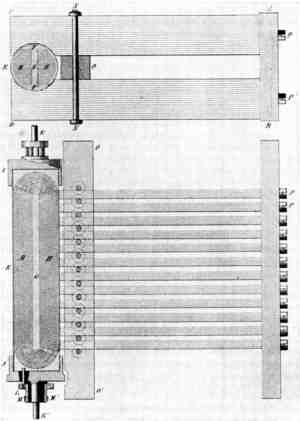 Siemens double-T armature winding Poggendorffs Annalen der Physik 101 (1857) Taf. II |
| 1861- 1864 |
James Clerk Maxwell (British) summarizes all the current knowledge of electromagnetism in 20 fundamental equations. Around 1882, Oliver Heaviside (British) uses vector calculus and reduces 12 of the equations further to just 4 equations with 4 variables. These equations are still valid today and fully describe the theory of electrical engineering. |
| 1866- 1867 |
Siemens develops the dynamo-electric machine based on the double-T armature. Finally, a powerful electric generator is available and the advent of electricity begins. |
| 1871 | The Siemens double-T armature has the disadvantage of producing a pulsating direct current.
Zénobe Théophil Gramme (Belgium) solves the problem by the invention of the anchor ring, which produces a smooth DC voltage. In subsequent years, Gramme's machines are in strong competition Siemens' double-T armature machines. Gramme's construction, however, is no longer used today. |
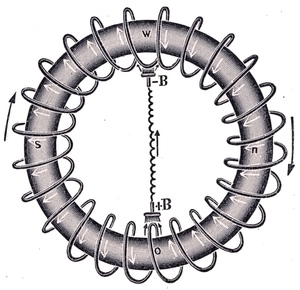 Gramme's anchor ring, 1871 Photo: Wikipedia |
| 1872- 1875 |
Friedrich von Hefner-Alteneck (German), a close associate of Werner Siemens, starts development of the anchor drum motor. He wraps wire around a cylinder-shaped anchor. This improves the double-T anchor machine, which can now also produce a smooth DC voltage. In 1875, he reduces the problem of eddy currents by using iron wires instead of solid iron for the magnetic core. |
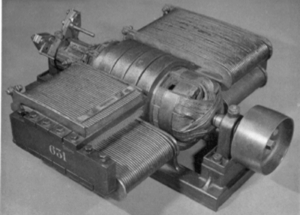 Siemens' drum armature, app. 1872 (sliced model) Photo: Science Museum, London |
| 1873 | Auguste Pellerin (Franzose) proposes to subdivide the iron core into several separate, mutually insulated steel sheets in order to avoid eddy current losses. He does not, however, pursue his idea any further. |
With Ritchie's commutator, the drum armature of Siemens and Hefner Alteneck and the lamination of the magnetic circuit all important design features of modern electric DC motors are known.
The future DC motor does not emerge from the developments of Jedlik, Jacobi, Davenport, Davidson, Page or other early inventors, whose designs are ultimately proven to be inferior, but from Siemens's dynamo machine.
J. Zoellner writes in 1885: "The history of electromagnetic motors ends in its childhood, or rather, goes along with the history of the dynamo."
Timetable 1885 - 1893: The three-phase system and the induction motor
| 1882-1889 | Nikola Tesla (Croatian, serbian roots) already thinks about a multi-phase voltage system while studying in Graz / Austria in 1882. He emigrates to America in 1884 and launches a small company and development laboratory in 1886 in New York. Meanwhile, the Italian professor Ferraris is successful in building a small two-phase induction motor in 1885 (see below). Tesla knows nothing of Ferraris' induction motor and reinvents it shortly thereafter. He also builds a series of functional models. Tesla falls out with its investors in 1886 and must now make his living as a laborer for the next two years, while he continues to work on his inventions. In 1887 Tesla files his first patents for a two-phase AC system with four electric power lines, which consists of a generator, a transmission system and a multi-phase motor. George Westinghouse becomes aware of Tesla in May 1888 due to his remarkable speech in Pittsburgh to the American Institute of Electrical Engineers. He buys his more than 40 patents for $ 1 million. In addition, Westinghouse hires Tesla as a consultant for his company. Tesla still fails to recognize the advantages of three-phase voltage systems. During his work at Westinghouse, he concentrates on two-phase and single-phase induction machines with relatively high frequencies (125 Hz and 133 Hz). Ultimately, he fails to build a reliable induction motor and leaves Pittsburgh and the Westinghouse Company dissatisfied in 1889. Westinghouse thereafter stops all developments of induction motors. Only after the German AEG company with Dolivo-Dobrovolsky's machines (see below) proves that reliable three-phase induction motors can be built, Westinghouse restarts its own developments of three-phase motors in 1892. These efforts are successful already in 1893 - however, without the involvement of Tesla, who had turned to other topics. |
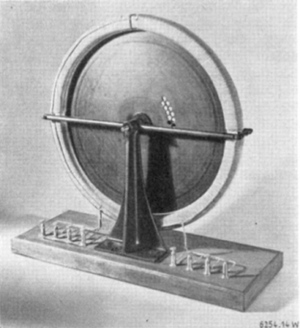 |
| 1885 | Galileo Ferraris (Italian) builds the first induction motor. Like Tesla, he uses two phases.
However, Ferrari believes incorrectly that such motors can never exceed an efficiency of 50%. He therefore loses interest and does not continue to develop his machines. |
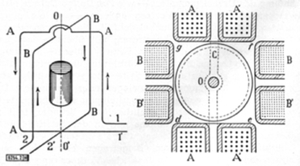 Schematic drawing of Ferraris' first induction motor from his patent application, 1885 |
| 1887- 1889 | Charles Schenk Bradley (US-American) has been experimenting with multi-phase generators already before the publication of Ferraris' work. In 1887/88 he is granted several US-patents on this subject. At first on two-phase and later also on three-phase systems. But Bradley never puts his inventions into practical use. |
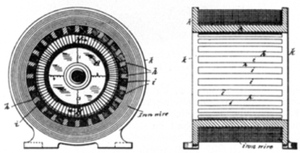 Bradley's induction motor from his patent application, 1887 |
| 1887- 1888 |
Friedrich August Haselwander (German) from Offenburg/Baden is the first one to come up with the idea to use a three-phase alternating voltage and current system in July 1887. He builds the first three-phase synchronous generator with salient poles. However, the German Post (postal authority) prohibits the operation of his machine for fear of disturbances of telegraph lines. Haselwander's patent applications fail as well. |
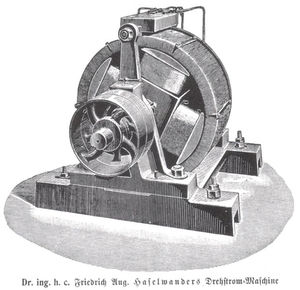 Haselwander's synchronous motor, 1887 |
| 1889-1891 | Michael Dolivo-Dobrowolsky (Russian, naturalized Swiss), chief electrician at the AEG company in Berlin, builds on the basic ideas of Tesla and Ferraris and improves them considerably. He designs the three-phase cage induction motor, which is still widely used today. In the beginning of 1889, his first motor is running properly. Later, Dolivo-Dobrovolsky also invents the three-phase slip ring induction motor with starting resistors. |
 Dolivo-Dobrowolsky's first three-phase cage-induction motor, 1889 Illustration from ETZ, 1917 [9] |
| 1889-1893 | In a British patent of April 1889 Jonas Wenström (Swedish) describes all components of a three-phase electrical power system. In 1890 he builds a three-phase generator. Three years later, in 1893, the first 13 km long AC power transmission system is installed in Sweden. Wenström probably knew nothing about the other participants although they were ahead of him by one or two years. |
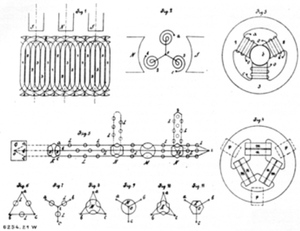 Sketch from Wenström's patent application, 1890 |
Energy Transmission
Dobrovolsky is the first one to realize that a three-phase system connected in star or delta requires just three power lines and thus is less expensive than even a two-phase system (which uses four lines).
In August 1889 he receives a patent on the invention of the three-legged three-phase transformer. This is the beginning of the world wide success of the three-phase alternating current system.
Under the leadership of Dolivo-Dobrowolsky and together with the Maschinenfabrik Oerlikon and its chief engineer Charles E.L. Brown, the AEG builds the first three-phase electric power transmission line in 1891 over 175 km from Lauffen (river Neckar) to Frankfurt am Main, which later reached a remarkable efficiency of 96%. The line could deliver up to 220 kW output power and was operated at voltages up to 25 kV.
Five years later in late 1896, the first U.S. american electric power line is inaugurated. Built by Tesla and Westinghouse it leads from the Niagara Falls to Buffalo, NY over a distance of 22 miles (35 km). This line is also a three-phase system, which Tesla has learned to appreciate in the meantime. However, three individual single-phase transformers were used at both ends of the line as the advantageous three-legged transformer construction had been patented by Dobrovolsky. The Niagara Falls line can deliver an output power up to 750 kW at voltages up to 11 kV.
Summary
Franz Hillebrand investigates the priority question on behalf of the Scientific Committee of the VDE in 1959 in a thorough study of the subject [10]. He remarks:
"... The solution of the problem was almost in the air, and so it is not surprising that similar paths of thought formed in many minds and almost simultaneously very similar solutions were created ...
One had the solution, at least in principle, already in his hands, but postponed their publication by three precious years because he fails to recognize its meaning due to an error of thought (Ferrari);
the other one was thoroughly familiar with the matter, gradually developed the technical solution in a usable form, but only in patent specifications and he did not seem to think of an implementation in reality (Bradley).
Another one got almost by chance the correct solution, instantly recognizes it thanks to his technical talent, instantly turns it into a small scale model in the right way in an amazingly short time, but has neither the gift nor the economic backing to bring his ideas to the breakthrough (Haselwander).
Another one fights for the solution in restless intellectual work, dreaming of fantastic views opened by his flights of thought, from the bondage of the forces of Niagara Falls and other things more, but does not possess the ability to quickly find a technically usable form, or inspire employees for his ideas (Tesla).
One clearly recognizes the problem, creates technically sound, well thought out solutions for the whole application area, but his solutions appear one to two years too late in the race (Wenström).
Next comes a man who knows the situation in the field of energy supply well, a sovereign master of the matter, who is used to overcome difficulties in the development of electric machines, who connects courage with decisiveness and has the great good fortune to be working with far-sighted economists (Dolivo-Dobrowolsky).
... How hard is it to distribute the merits properly on this background! ...
Tesla was the first to work intensively on electric power transmission through a multi-phase alternating current system, he was the first to find the basics for such a transfer and was the first to present the principles of a multi-phase induction motor.
Bradley filed the first patent on a two-phase AC power transmission system with synchronous machines and four electric wires. He also created the first patent for a three-phase induction motor with a completely shorted-circuited rotor winding (squirrel-cage induction).
Haselwander was the first to design a three-phase transmission system with three-phase synchronous machines and three transmission lines. He built the first such facility, and gave it first into practical use.
Dolivo-Dobrowolsky built the first simple, practically useful three-phase induction motor with squirrel cage rotor. In broad scientific lectures and essays, he explained nature and characteristics of the three-phase current system and three-phase motors ... and two years after the construction of his first 1/10 hp induction motor he put a 100-horsepower three-phase motor into normal operation ... Dolivo-Dobrowolsky must therefore be seen as the pioneer for the introduction of the three-phase current system. "
Literature
[1] G. Neidhöfer, Michael von Dolivo-Dobrowolsky und der Drehstrom, Geschichte der Elektrotechnik Band 19, VDE Verlag Berlin, 2004
[2] K. Jäger (Hrsg.), Alles bewegt sich, Geschichte der Elektrotechnik Band 16, VDE Verlag Berlin, 1998
[3] H. Lindner, Elektromagnetismus als Triebkraft im zweiten Drittel des 19. Jahrhunderts, Dissertation TU Berlin, 1986
[4] O. Mahr, Die Entstehung der Dynamomaschine, Geschichtliche Einzeldarstellungen aus der Elektrotechnik, VDE, Verlag Julius Springer, 1941
[5] B. Bowers, Die Frühgeschichte des Elektromotors, Philips Technische Rundschau, 35. Jahrgang, 1975/76, Nr. 4, S. 85-104
[6] A. Imhof, Die ersten Elektromotoren, Bulletin des SEV Elektrotechnik, 70(1979)23, Seite 1241-1246
[7] T. Davenport, Improvement in propelling machinery by magnetism and electro-magnetism, United Stated Patent Office Patent No. 132, February 25, 1837
[8] J. Zöllner, Die elektromagnetischen Apparate, Buch der Erfindungen, Gewerbe und Industrien, Band 2, S. 360 – 380, Verlag Otto Spamer, Berlin/Leipzig, 1885
[9] M. Dolivo-Dobrovolsky, Aus der Geschichte des Drehstroms, ETZ Elektrotechnische Zeitschrift, Bd. 38 (1917), Heft 26, S. 341-344, Heft 27, S. 354-357, Heft 28, S- 366-369 und Heft 29, S. 376-377
[10] F. Hillebrand, Zur Geschichte des Drehstroms, ETZ-A Elektrotechnische Zeitschrift, Ausgabe A Bd. 80 (1959) Heft 13, Seite 409-421 und Heft 14, Seite 453-461
[11] M.H. Jacobi, Mémoire sur l’Application de l’Électro-Magnétisme au Mouvement des Machines, Potsdam, Spring 1835
[12] T.D. Visser, Smalley-Davenport Shop Forestdale, Vermont, http://www.uvm.edu/~histpres/SD/hist.html, 1995
[13] W.J. King, The development of electrical technology in the 19th century. Part 1: The electrochemical cell and the electromagnet, Bulletin of the United States National Museum, 228(1962), S. 231 – 271
[14] J. Abele, G. Mener, Technikgeschichte – Der Tesla Motor, Deutsches Museum, 1995
[15] B. Silliman, Notice of the Electro-Magnetic Machine of Mr. Thomas Davenport, of Brandon, near Rutland, Vermont, American Journal of Science and Arts, Vol. 32, July 1837, Appendix, p. 1-8
[16] P. Hempel, Deutschsprachige Physiker im alten St. Petersburg: Georg Parrot, Emil Lenz und Moritz Jacobi im Kontext von Wissenschaft und Politik, Oldenbourg Wissenschaftsverlag, 1999
[17] W.R. Davenport, J. Hartness, Biography of Thomas Davenport, the Brandon Blacksmith: Inventor of the Electric Motor, Kessinger Publishing, 2010 (Faksimile Reprint)
[18] The Mechanics' Magazine, Museum, Register, Journal and Gazette, London; Ausgabe 1837, S. 159, 160, 404, 405; Ausgabe 1838, S. 115, 322, 323, 426-428, 441, 442; Ausgabe 1840, S. 407-408; Ausgabe 1852, S. 22-25
[19] Journal of the Franklin Institute, Vol. 24, Issue 5, Nov. 1837, S. 340-343
[20] F. Watkins, On Magneto-electric Induction, Philosophical Magazine and Journal of Science, London and Edinburgh, Vol. 7, August 1835, S. 107-113
[21] F. Watkins, On Electro-magnetic Motive Machines, Philosophical Magazine and Journal of Science, London and Edinburgh, Vol. 12, Februar 1838, S. 190-196
[22] C.G. Page, Magneto-Electric and Electro-Magnetic Apparatus and Experiments, American Journal of Science and Arts, Vol. 35, January 1839, p. 252-268
[23] W. Siemens, Über eine neue Konstruktion magneto-elektrischer Maschinen, Poggendorffs Annalen der Physik und Chemie, Ausgabe 101, 1857, S. 271-274
[24] F.L. Pope, The Inventors of the electric motor, The Electrical Engineer, Vol. XI, 1891, No. 140, S. 1-5 und No. 141, S. 33-39
[25] M.H. Jacobi, Notiz über Elektromagnete, Poggendorffs Annalen der Physik und Chemie, Ausgabe 31, 1834, S. 367-368
[26] J.C. Poggendorff, Jacobi's Commutator, Poggendorffs Annalen der Physik und Chemie, Ausgabe 36, 1835 , S. 366-369
[27] M.H. Jacobi, Ueber die Principien der elektro-magnetischen Maschinen, Poggendorffs Annalen der Physik und Chemie, Ausgabe 51, 1840, S. 358-372
[28] C.Th. Moncel, F. Geraldy, Electricity as a motive power, E.&F.N.Spon, London, 16, Charing Cross., 1883
[29] M.H. Jacobi, On the application of electro-magnetism to the moving of machines, The Annals of Electricity, Magnetism & Chemistry, Vol. 1, July 1837, S. 408 ff. and Vol. 1, October 1837, S. 419 ff.
[30] W. Sturgeon, His electro-magnetic engine, The Annals of Electricity, Magnetism & Chemistry, Vol. 1, October 1836, S. 76 ff.
[31] E. Lenz, Ueber die Bestimmung der Richtung der durch elektrodynamische Vertheilung erregten galvanischen Ströme, Poggendorffs Annalen der Physik und Chemie, Ausgabe 31, 1834, S. 483-494
[32] E. Lenz, Ueber die Beziehung zwischen elektromagnetischen und magneto-elektrischen Strömen, Poggendorffs Annalen der Physik und Chemie, Ausgabe 44, 1838, S.347-349
